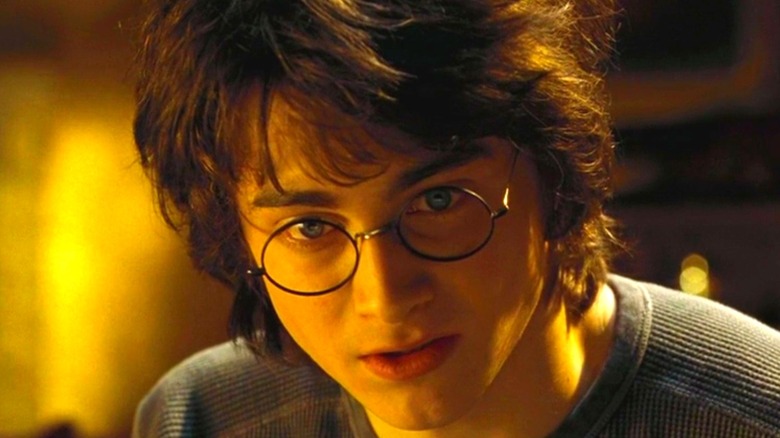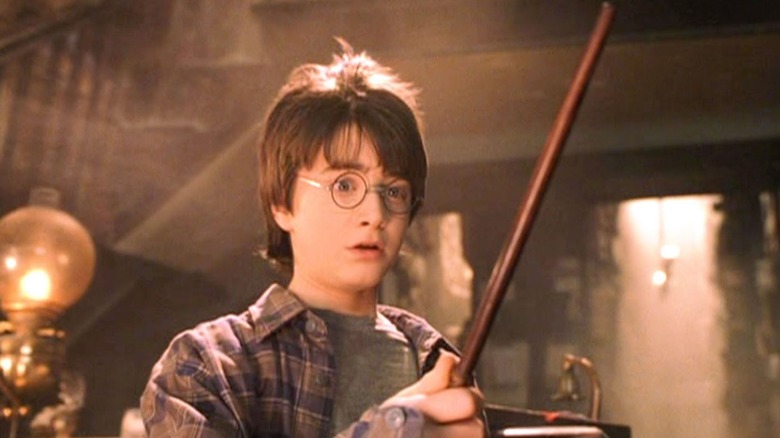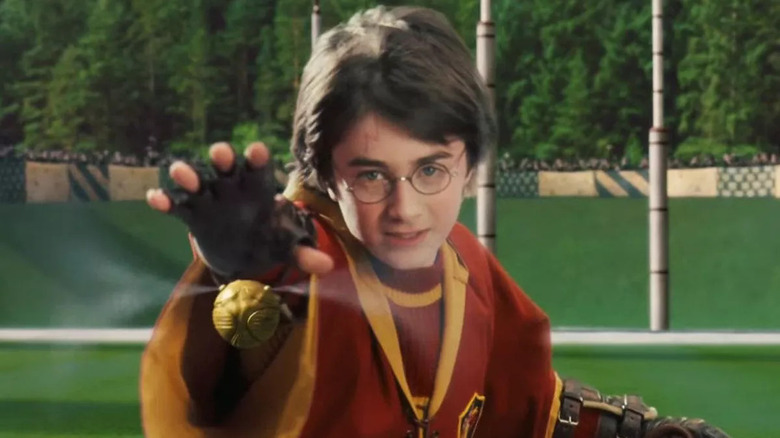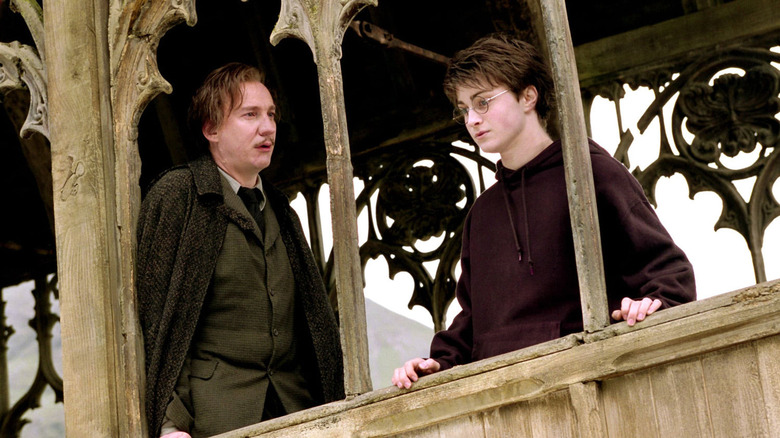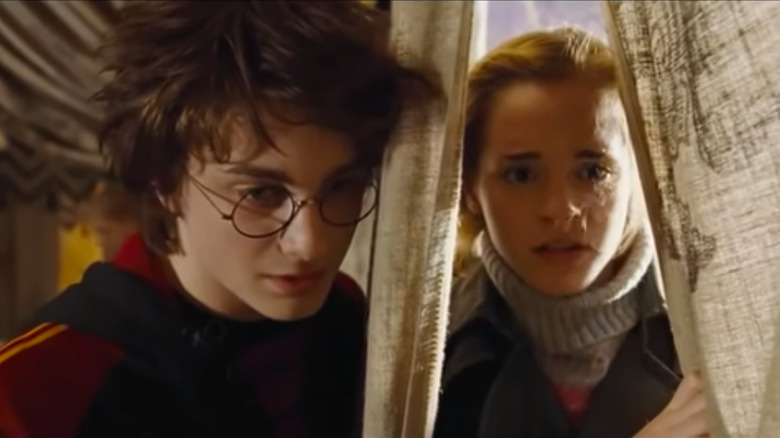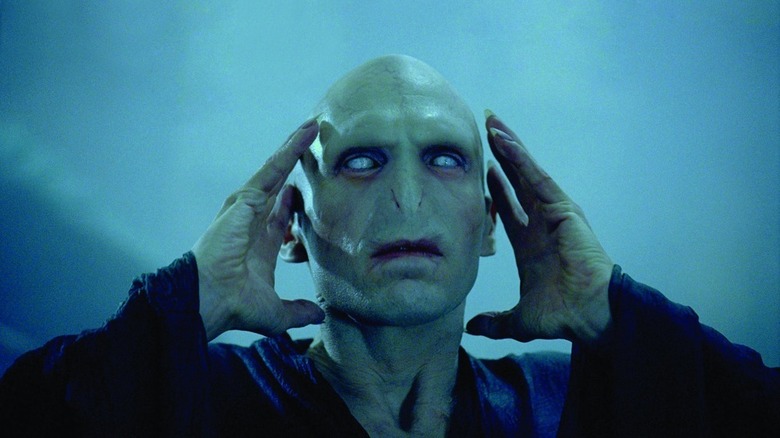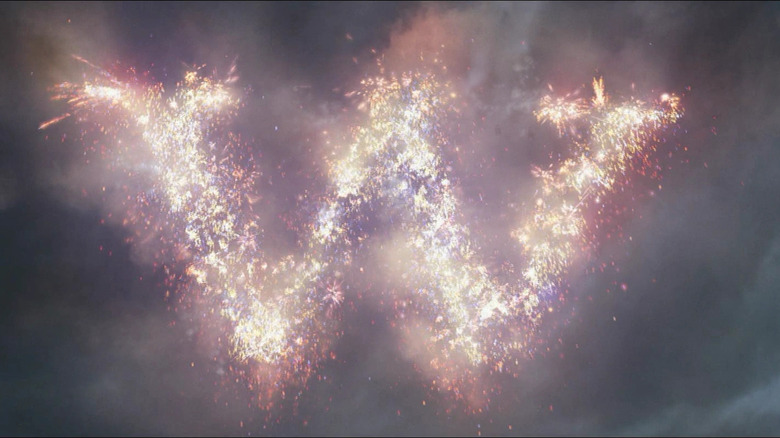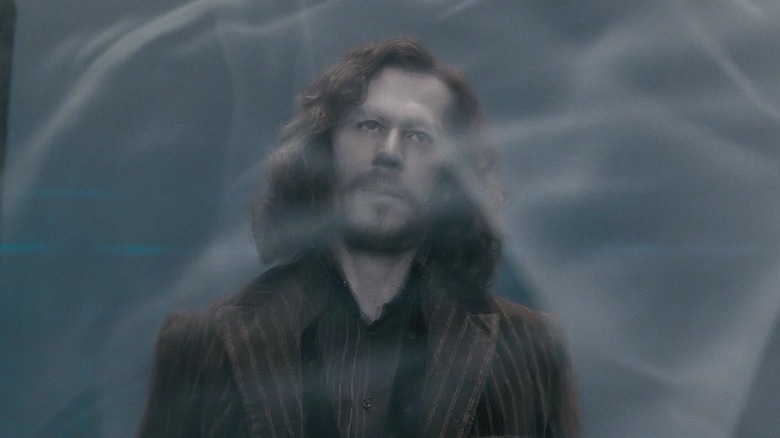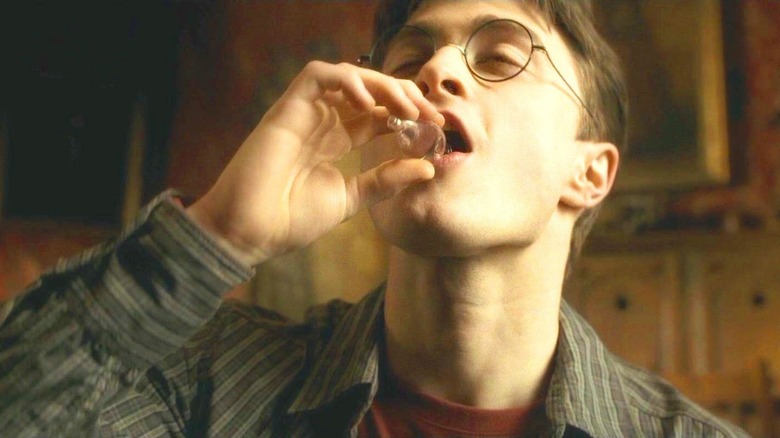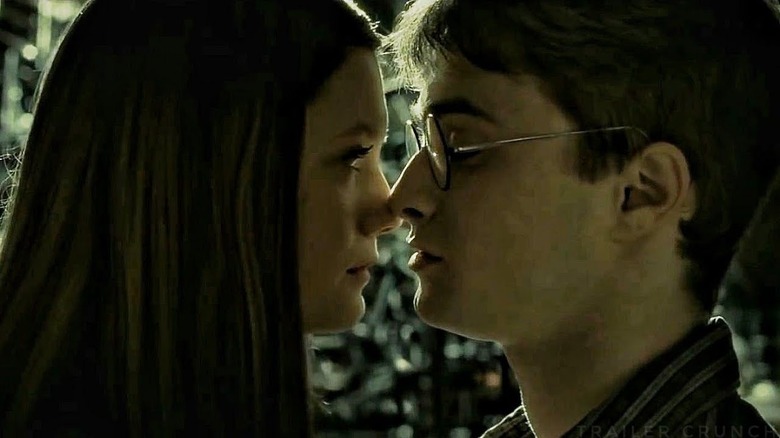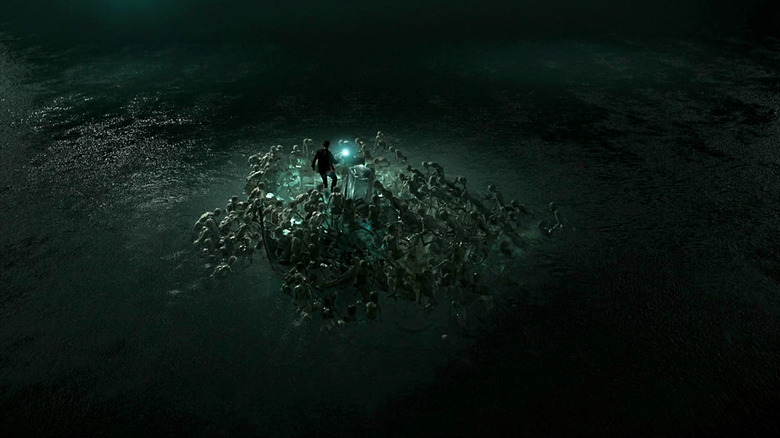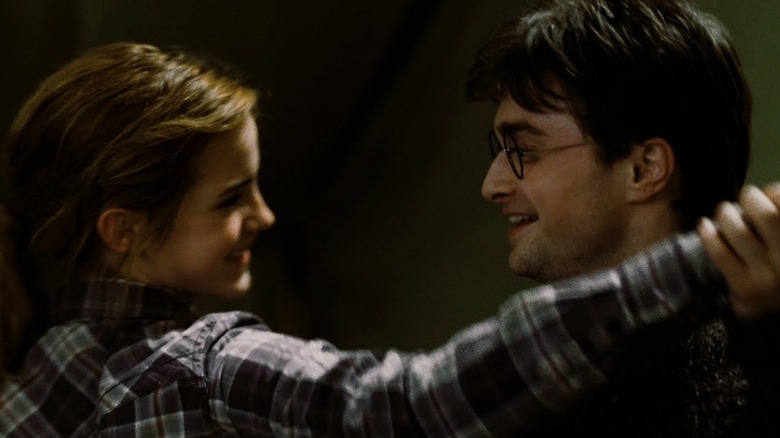11 Harry Potter Moments That Are Better In The Movies Than In The Books
Book adaptations are tough. There's so much material that needs to be compacted to fit an entire novel into a film, and few adaptations manage to be successful. That said, no matter how the "Harry Potter" movies are individually ranked, they will likely go down in history as some of the greatest book adaptations of in cinema history. The "Harry Potter" movies manage to be mostly faithful to a series that spans over a million words. Even minor characters from the novels get a chance to shine in the films, and only a few side plots throughout the series had to be cut for time.
What makes the "Harry Potter" movies even more impressive is that they manage to elevate and add to one of the most successful book series of all time. So much of "Harry Potter" is improved by being visualized onscreen, and there are scenes changed and invented for the films that work better than their counterparts in the novels. Of course, the books will always be better for diehard fans or anyone wanting a deeper look at the Wizarding World — but on several occasions, that the "Harry Potter" movies were better than the books.
Harry getting his wand
Harry taking a trip to Ollivander's to pick out his wand takes up just a few pages of the chapter "Diagon Alley" in "Harry Potter and the Sorcerer's Stone." It's an important part of the story, as it starts to establish the curious link between Harry and Voldemort, but it's hardly a stand out moment of the first novel. The film spent more time on the scene and turned it into one of the most iconic moments in all of "Harry Potter."
Seeing the explosive consequences of the wrong wands really sells the importance of every witch and wizard finding a wand that chooses them. Daniel Radcliffe's astonishment throughout the exchange is contagious, but it's really John Hurt's performance that solidifies this scene as one of the greatest in the series. The "Harry Potter" series found a magically successful formula by pairing young actors with British greats, and the Ollivander scene is a perfect example of that. Hurt, who sadly passed away in 2017, delivers multiple lines that are endlessly quotable, from "The wand chooses the wizard, Mr. Potter" to "Curious, very curious."
Quidditch
Witches have been riding broomsticks for ages, but what "Harry Potter" does with the trope might be one of the series' greatest inventions. Harry is first introduced to the wizard sport Quidditch during his first year at Hogwarts, and he also learns that his father was a star player on the Gryffindor team. Harry becomes the Gryffindor seeker, responsible for catching the Golden Snitch and ultimately winning the game for his team.
Reading the Quidditch scenes in the books is great, but getting to see a match played out on the big screen is much more exciting. Since Quidditch only appears in a few "Harry Potter" movies, each of the scenes are worth savoring. Harry's first match in "The Sorcerer's Stone" is particularly memorable. Daniel Radcliffe perfectly captures the anxiety of an 11-year-old who's competing for the first time in front of the entire school. The match itself is fast-paced and kinetic and contains one of the best Snitch catches in the series: Harry stands on his broom, only to fall and narrowly capture the Snitch in his month. Even better, that catch comes back around as an important detail in "The Deathly Hallows."
The development of Remus and Harry's friendship
According to Rotten Tomatoes, "Harry Potter and the Prisoner of Azkaban" is the second best reviewed film in the series. The film takes a darker tone than previous entries in the franchise, and it features some of the most memorable creatures in the Wizarding world, like Boggarts, Hippogriffs, and, of course, Dementors. "The Prisoner of Azkaban" really begins digging into the backstory of Harry's parents and their fight against Voldemort. Along the way it introduces some incredible characters like Peter Pettigrew, Sirius Black, and Remus Lupin.
Professor Lupin connects with Harry on a deep level because of his relationship with Harry's parents. For the first time, Harry has found someone who was truly close with his mother and father, and willing to open up about what they were like. The friendship that grows between the two of them is a highlight of the book, but it's brought to a whole new level by David Thewlis's performance in the film. Thewlis portrays Lupin as warm and caring, yet just reserved enough that audiences not already familiar with the story could keep guessing at his motivations. This stays true until the final reveal of both his relationship with Sirius and his lycanthropy at the end of the film. One of the best moments in the film comes when Harry and Lupin are standing on the Covered Bridge. Lupin is reminiscing about his relationship with James and Lilly and tells Harry that he has his mother's eyes.
Harry and Hermione meeting before the Hungarian Horntail
"Harry Potter and the Goblet of Fire" sees a wedge driven between Harry and Ron for the first time in the series. As Harry is thrust into the Triwizard Tournament without the support of his best friend, Hermione and he grow closer than ever. Hermione is the only person who believes Harry when he says he didn't put his name in the Goblet of Fire, and she's the main person he relies on in the lead up to the first challenge.
In a moment that was invented for the movie, Harry and Hermione share a moment in the champions' tent just before he faces off against the Hungarian Horntail. Hermione's gentle encouragement that everything is going to be alright is heartwarming, and they're conversation is beautifully shot. It's also one of the last light scenes before the film plunges into the dark return of Lord Voldemort.
Every "Harry Potter" fan has their own favorite couple in the series, and plenty of them believe Harry and Hermione belonged together. Watching this moment, it's easy to see why. Harry's and Hermione's exchange is also enough to convince Rita Skeeter that their relationship is romantic as she snatches a picture for The Daily Prophet. Ultimately, though, this conversation just proves the strength of their friendship.
Voldemort's return
The "Harry Potter" series was building to Voldemort's return for a long time. He-Who-Shall-Not-Be-Named made his first attempt to come back to life in "Harry Potter and the Sorcerer's Stone" by using Professor Quirrell to go after the secret to immortality. In "Harry Potter and the Chamber of Secrets" a piece of Voldemort's soul made a play for life from Tom Riddle's diary-turned-Horcrux. In "Harry Potter and the Goblet of Fire," Voldemort finally comes up with a plan that succeeds. He regains his body in one of the most dramatic scenes in the entire franchise.
Voldemort's return in the chapter "The Death Eaters" is one of the darkest moments in all of Harry Potter. Cedric Diggory dies, then the Dark Lord rises and proceeds to torture Harry with the cruciatus curse before the two of them duel head-to-head. As intense as Voldemort is on the page, Ralph Fiennes brings the terror of pure evil to life in a way few had anticipated. Daniel Radcliffe said on The Jess Cagle Interview (via Entertainment Weekly) that he was actually terrified of Fiennes when he stepped into character. "I remember when I was 15 doing scenes with Ralph for the first time ... [he] genuinely scared me for a few years." J.K. Rowling created a fantastic villain in her books, but he's even better in the movies.
Fred and George leaving Hogwarts
The fifth "Harry Potter" movie dives into darkness as Voldemort climbs his way to power and the mainstream wizarding world turns its back on Harry and Dumbledore. The world is becoming a scarier place out of Hogwarts, and the Ministry of Magic is wreaking havoc inside the school with the help of Delores Umbridge -– the real worst villain in the "Harry Potter" franchise. Umbridge cracks down on student freedoms, refuses to teach spellcasting in her Defense Against the Dark Arts classes, fires Hogwarts professors, and eventually forces Albus Dumbledore to leave the school so she can become Headmistress.
Harry and his friends do their best to resist Umbridge's rule, forming a secret group called Dumbledore's Army to continue teaching each other defensive magic. Despite their admirable efforts, it ends up being the Weasley twins who land the most satisfying blow against Umbridge — and reintroduce some levity to the film. Fred and George are both in their last year of school, and the two of them are much more concerned with starting their own business –- Weasley's Wizard Wheezes –- than with passing their final exams.
The twins decide to abandon Hogwarts while making one last show of mischief and misbehavior. In the middle of the fifth years taking their O.W.L. exams, the twins mount broomsticks and zoom through the school's halls, lobbing magical fireworks through the air. There's nothing Umbridge can do to stop them, so the twins make a party of disrupting school activities in the most joyous scene in the entire film.
Sirius's death
"Harry Potter and the Order of the Phoenix" barely lets up from its dark tone. The doom and gloom carries through the end of the film, when Harry suffers the greatest loss since the death of his parents. In the books, the moment of Sirius Black's death gets confused amidst the ongoing battle within the Ministry of Magic. It's not until Harry makes his way back to Hogwarts that he's able to really process what happens. The film compresses the timeline and makes Sirius's death the true climax of the story.
The Order of the Phoenix is battling against a group of Death Eaters deep within the Department of Mysteries at the Ministry of Magic. The fight takes place in a room housing a massive stone arch with a swirling veil of darkness at its center. Sirius ends up shooting spells back and forth with Bellatrix Lestrange, and she lands a stunning spell, knocking him back into the veil. Just like that, Sirius's body is carried away into the darkness.
As Harry witnesses his godfather's death, the sounds of the battle fade out and his rage overtakes him. He chases Bellatrix into the Ministry's entrance hall, fully intending to end her life with the killing curse. Voldemort sees an opportunity to corrupt Harry, but it's his love of Sirius that pulls him back to his senses — and ends the inner struggle he's been dealing with throughout the film.
Felix Felicis
The sixth "Harry Potter" films sustains the darker tone that overtook the series when Voldemort made his return in "The Goblet of Fire." Now that the Ministry believes Voldemort has returned, the fight between good and evil is reaching a peak of open warfare. In the midst of violent attacks on muggles and fraying loyalties within the ranks of the wizarding world, "Harry Potter and the Half-Blood Prince" gives fans one of the funniest scenes in the entire franchise.
Dumbledore tasks Harry with convincing Professor Slughorn to give up one of his old memories of a conversation between himself and a young Tom Riddle. After numerous attempts, Harry finally decides that his best route to success is to use Felix Felicis, a potion known as "liquid luck." The main difference between the book's depiction of what happens next and the film's is Daniel Radcliffe himself. His portrayal of the potion's effect on Harry is a cross between childlike overconfidence and outright drunkenness. He walks around the castle grounds with a goofy grin on his face and chances his way into success, all the while seeming unconcerned with everything happening around him. It's the film's only laugh-out-loud moment and one of Radcliffe's best performances in the series.
Harry's and Ginny's first kiss
While the wizarding world is falling to pieces in "Harry Potter and the Half-Blood Prince," Harry and his friends are falling in love. Ron gets his first girlfriend, and Hermione gets overtaken with jealousy. Harry finds himself caught awkwardly between the two of them, but the situation gets even worse for him when he realizes that he has feelings for Ron's sister, Ginny. Throughout most of the film, Harry is battling his own jealousy as he watches Ginny's relationship with Dean Thomas. Harry finally sees an opportunity when the couple breaks up, but he doesn't end up being the one to make the first move.
In the books, Harry and Ginny first kiss in the excitement of a Quidditch victory. The movie goes for a quieter, sweeter moment instead, and it works well as a counterbalance to the chaos that's rocking the rest of the wizarding world. After Harry attacks Malfoy with a spell he found in the margins of the Half-Blood Prince's textbook, he realizes that it's time to part ways with the book that's helped him through Potions class all year. Ginny takes him to the Room of Requirement to help him hide the book in a place where it will never be found. She asks him to close his eyes while she hides the book, and then she goes in for a kiss. Love or hate the Harry/Ginny pairing, there's no denying the power of their first romantic moment together.
Voldemort's cave
The "Harry Potter" movies are usually thought of as being for kids and teens, but just about every entry in the series has flirted with horror in one form or another — from the giant spiders in "The Chamber of Secrets" to the Dementors of "The Prisoner of Azkaban." The sixth film finally delivers a scene that terrifies on almost every level. Dumbledore asks for Harry's help in retrieving a Horcrux from an oceanside cave, and the two of them plunge into the adventure without any real idea of what awaits them.
Within the cave, Dumbledore and Harry find a small lake with a rocky outcropping at its center. Atop the rocks is a basin of some strange liquid that protects the Horcrux. Dumbledore has to drink the liquid, but whatever it is causes him immense pain and suffering the moment it touches his lips. In the darkness of the cave, Harry must force Dumbledore to continue drinking the potion, even as the Headmaster begs for death.
Eventually the liquid is gone, and Harry goes to scoop some water for Dumbledore to drink. At that moment, reanimated corpses rise from the depths of the cave's lake, and the pair fights their way out with magic. While the scene isn't significantly changed from its book counterpart, the movie really instills the terror of Voldemort's first hiding place.
Harry and Hermione dance in 'The Deathly Hallows'
Harry and his friends reach their lowest point in "The Deathly Hallows Part 1." Hermione has wiped her parents' memories to protect them from the Death Eaters. Ron has abandoned his family to join the search for Voldemort's Horcruxes, and without much guidance from Dumbledore, Harry has no idea where to lead his friends. Eventually, both the frustration and the evil energy from Voldemort's locket become too much for the group. Ron leaves, and Harry and Hermione find themselves traveling alone through the woods.
From that low point, the film reminds its audience what's at the real heart of the franchise: Friendship. Harry and Hermione can barely speak to each other in Ron's absence. One night a song plays on their radio, and Harry reaches out to Hermione's hand for a dance. The two of them sway to the music and smile for the first time in weeks. Neither of them knows that Ron will soon return, or that the worst is nearly over, but they both remember why they're fighting. The peace only lasts a moment before the sadness of Ron's absence settles back in, but the dance is one of the film's best contributions to "Harry Potter."
